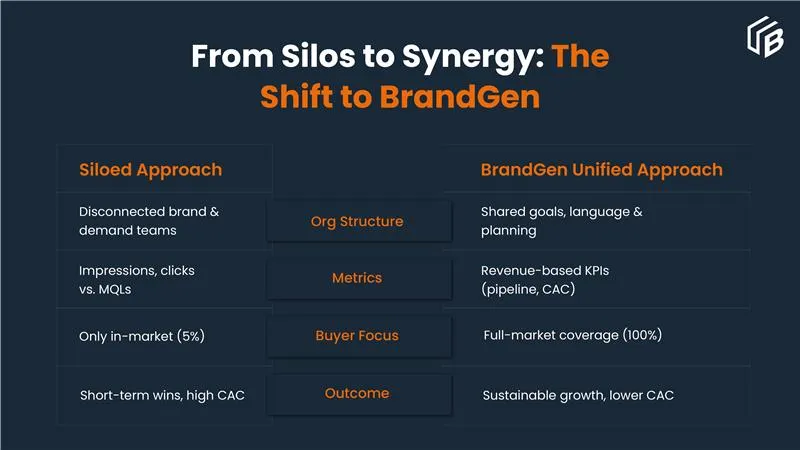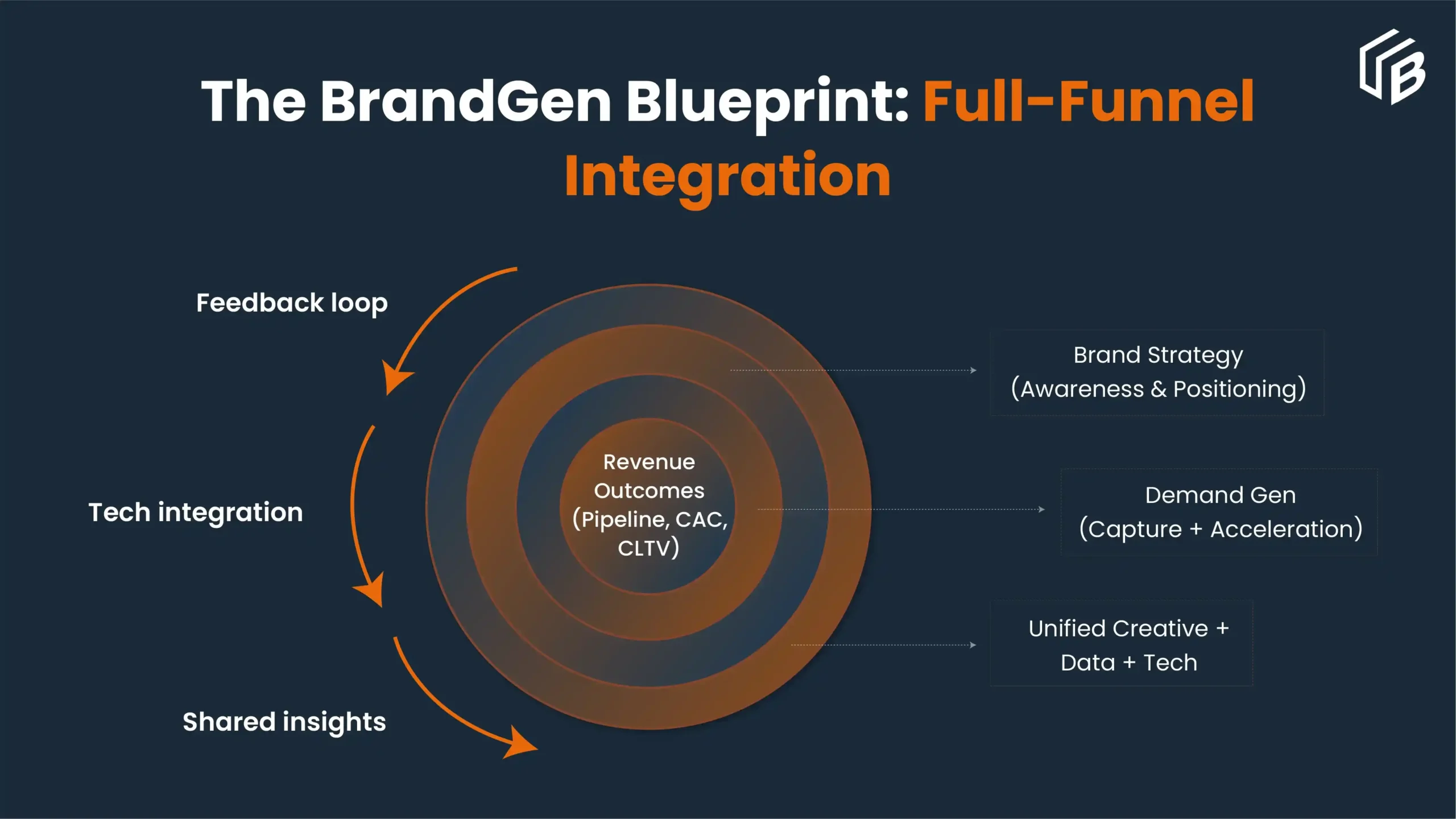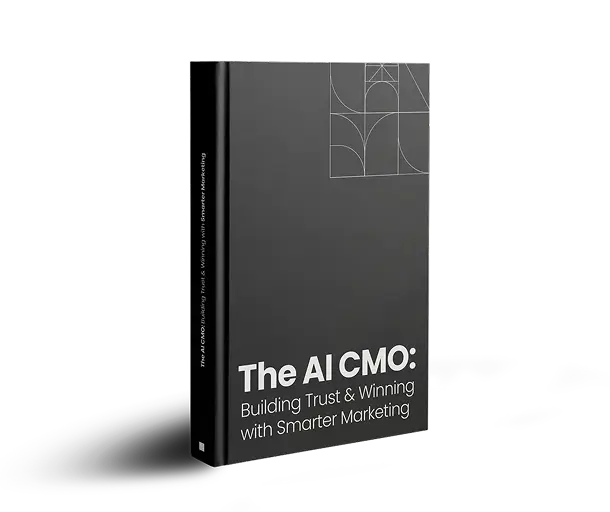Introduction
Today’s B2B marketing landscape is unforgiving. Building a strong pipeline is more challenging — and expensive — than ever before. For years, marketing leaders like you have been forced into a false choice of brand awareness versus demand generation: invest in building positive awareness or focus solely on driving pipeline. Under constant pressure to show immediate ROI, many CMOs have chased short-term wins by prioritizing metrics like MQLs and lead volume.
That strategy boosts numbers in the moment — a vital function — but sacrifices long-term brand building and equity. The result is a “Growth Trap” marked by diminishing returns, rising customer acquisition costs (CAC), and falling conversion rates. The problem is that the approach targets only the roughly 5% of buyers actively searching today, leaving the remaining 95% largely untouched.
Recent analyses highlight the importance of balancing brand and performance in B2B marketing. The “
Multiplier Effect” report indicates that integrating brand and performance marketing can significantly boost return on investment (ROI) for businesses. Over-investing in performance advertising can reduce ROI by 20-50%, while a balanced mix can lift ROI by 25-100%, with an average increase of 90%. The report suggests allocating 40-60% of marketing budgets to brand marketing to achieve this balance.
Brand vs. Demand Silos Are the Real Reason Behind the Growth Trap
Traditionally, B2B marketing has been divided into segments. Brand teams focus on creating
top-of-funnel awareness with metrics such as impressions, engagement, and share of voice. On the other hand, demand teams chase immediate conversions and pipeline numbers. This split is reinforced by organizational structures and technology that don’t communicate well enough.
The push for quick, quarterly results further embeds this divide, making it hard to prove the long-term value of brand-building — especially when its effects may not be visible for months. As a result, marketing rarely operates as a cohesive unit, trapping organizations in inefficient cycles of rising CAC and lower conversion rates.
It’s Time for BrandGen
BrandGen is UnboundB2B’s integrated GTM framework to unify B2B brand positioning, campaign execution, and demand generation around a single, revenue-focused strategy. It helps brands engage earlier, convert faster, and scale more efficiently — with commercial outcomes (not awareness) as the primary goal.
How Brand Multiplies Demand and Why BrandGen Works
Brand and demand aren’t competing forces. Brand marketing works as a top-of-funnel activity that establishes familiarity and trust, ensuring that when prospects begin their purchasing exploration, they recognize and prefer your brand. Research shows that prospects need multiple touches — often six or seven — before they’re ready to buy, highlighting the importance of nurturing relationships and long-term demand through consistent, reliable messaging.
Collaboration within the
BrandGen framework multiplies results. Companies that merge brand and demand see many tangible benefits: lower CAC, shorter sales cycles, and more sustainable pipeline growth. Our case studies back this up — SAS, Juniper Networks, and LinkedIn all report significant improvements in metrics and overall financial performance when brand and demand work together.
Escape the Trap by Taking the BrandGen Approach
To break free from the growth trap, your organization needs to dismantle traditional fragmentation and adopt a unified plan. The BrandGen framework offers a clear roadmap and your results will pivot around your team’s adaptation and execution. However, there are some clear facets that need your attention:
- Align Internal Teams :
Break down the barriers between brand and demand functions. Establish a shared language and common objectives so that marketing, sales, and leadership work toward unified business outcomes.
- Integrate Investment Planning and Media :
Align the brand and demand investment in your B2B marketing budget under one centralized media plan. A common recommendation is to allocate 15–20% of your demand generation budget to brand initiatives, with evidence suggesting that even up to 46% investment in brand can yield superior results.
- Unify Creative Platforms and Content Strategy :
Develop creative platforms that span the entire funnel. Ensure that messaging remains consistent — from high-level thought leadership to precise demand assets — and design calls to action that evolve with the buyer’s journey.
- Activate Your Full Funnel :
Coordinate activities across all your channels — paid search, content syndication, account-based marketing, and sales outreach. Use orchestration platforms to support timely follow-ups and strategic drip campaigns, ensuring that every touchpoint nudges your prospects closer to conversion.
- Integrate Technology and Data Management :
Invest in unified data platforms and integrated technology solutions that support a consistent tracking system. Enhanced lead scoring and advanced attribution models can capture the full impact of brand interactions on pipeline growth.
- Measure Effectiveness :
Redefine success by aligning “money KPIs” across both brand and demand. Track measures such as pipeline contribution, CAC efficiency, and brand-assisted conversions. By demonstrating a clear link between brand strength and demand performance, you can validate and refine your integrated investment.
Let’s Debunk Common Myths
Many CMOs resist brand investment with common arguments. Two frequent objections are:
“We don’t have time for brand. We need pipeline now.”
Focusing solely on the active 5% may yield quick gains, but it ignores your future buyers. This short-term approach leads to fierce competition, drives up acquisition costs, and jeopardizes long-term growth. A the same time, balancing brand and pipeline can lift ROI by 25-100%,
“Brand marketing doesn’t drive measurable results.”
Even though brand impact can be harder to quantify immediately, integrated measurement systems prove its value. Metrics such as a 58% higher CTR from brand-enhanced campaigns or LinkedIn’s booking uplifts substantiate that brand investment directly enhances demand performance.
An integrated strategy isn’t just about immediate wins — it’s essential for sustainable growth.
Why CMOs Need to Act Now
As AI-driven insights, evolving buyer behaviors, and larger buying groups reshape the market, the old, unaligned approach becomes increasingly outdated. The future belongs to companies that unify brand and demand to build a comprehensive, full-funnel strategy. Integrating brand storytelling with demand acceleration not only enhances pipeline metrics but also delivers sustainable competitive advantages in our complex, ever-changing marketplaces.
Seize Your B2B Advantage
CMOs face a critical choice between continuing with fragmented tactics that cater only to the immediate in-market buyers and embracing a unified strategy that captures the entire spectrum of buyer behavior. The BrandGen approach steps beyond the brand versus demand debate and fuses B2B brand awareness and demand capture into a single revenue engine, breaks down long-standing divisions and reduces rising CAC.
In today’s competitive B2B landscape, the real decision isn’t whether to invest in brand awareness or demand generation — it’s about executing a cohesive strategy that drives both immediate and long-term growth. Embrace BrandGen, challenge the status quo, and position your organization for lasting market leadership.












